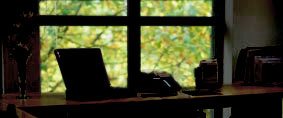|
The
TV Camera > Operating Characteristics > Contrast
Ratio
|
Here's
a great illustration of the
problem of TV's limited contrast ratio.
Remember, the outdoors is typically
1000 times brighter than an interior.
The top picture shows the scene as
your eyes see it. Notice how your
eyes can see detail in BOTH the outside
trees AND the items on the desk--despite
the brightness differential.

Unfortunately,
the image below is what a TV
camera sees. TV cameras can't handle
the brightness differential. If you
set the exposure for the items on
the desk; then the trees--which are
MUCH brighter--just go completely
white.

Let's
say you adjust the exposure of the
TV camera for the trees. It's a good
idea--except that now, everything
on the desk becomes too dark (See
below). You can't win.

This
is the biggest reasons many experts
think TV cameras are inferior to film
cameras. TV's contrast ratio is much
more limited that film; or your eyes.

|
|
|
CONTRAST
RATIO:
Contrast Ratio refers to the range of both light and
dark images we can see (or a camera can reproduce).
The
human eye is very good at seeing detail in both bright
and dark things at the same time. Our eye's contrast
ratio is approximately 1000:1. That means, for example,
you can look out a window and see detail in the outside
scene AND detail in the room simultaneously--even though
the outside is 1000 times brighter (on a sunny day,
it really is 1000 times brighter!).
A
television camera cannot handle such a range. Going
back to our window scene--if you set the exposure to
see detail outside, the inside will be a silhouette.
If you set the exposure for the inside, the outside
will be washed out white.
TV's
contrast ratio is a measly 30:1. For comparison, a color
slide, or a projected film, have a contrast ratio of
400:1. Not as good as the eye, but a lot better than
television.
|